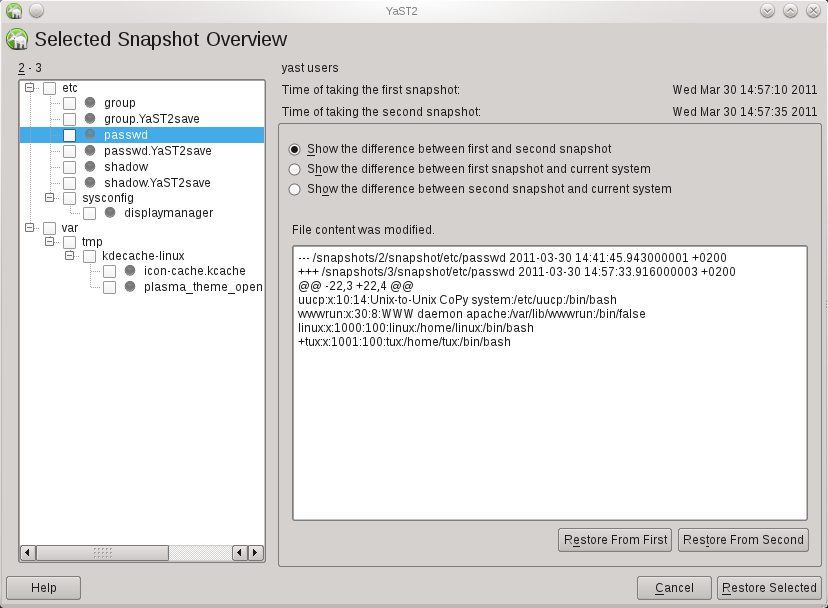Today we want to present the current development of snapper, a tool for managing btrfs snapshots.
For years we had the request to provide rollbacks for YaST and zypper but things never got far due to various technical problems. With the rise of btrfs snapshots we finally saw the possibility for a usable solution. The basic idea is to create a snapshot before and after running YaST or zypper, compare the two snapshots and finally provide a tool to revert the differences between the two snapshots. That was the birth of snapper. Soon the idea was extended to create hourly snapshots as a backup system against general user mistakes.
The tool is now in a state where you can play with it. On the other hand there is still room and time for modifications and new features.
Overview
We provide a command line tool and a YaST UI module. Here is a brief tour:
First we manually create a snapshot:
# snapper create --description "initial"
Running YaST automatically creates two snapshots:
# yast2 users
Now we can list our snapshots:
# snapper list Type | # | Pre # | Date | Cleanup | Description -------+---+-------+--------------------------+----------+------------- single | 0 | | | | current single | 1 | | Wed Mar 30 14:52:17 2011 | | initial pre | 2 | | Wed Mar 30 14:57:10 2011 | number | yast users post | 3 | 2 | Wed Mar 30 14:57:35 2011 | number | single | 4 | | Wed Mar 30 15:00:01 2011 | timeline | timeline
Snapshot #0 always refers to the current system. Snapshot #2 and #3 were created by YaST. Snapshot #4 was created by an hourly cronjob.
Getting the list of modified files between to snapshots is easy:
# snapper diff 2 3 c... /etc/group c... /etc/group.YaST2save c... /etc/passwd c... /etc/passwd.YaST2save c... /etc/shadow c... /etc/shadow.YaST2save c... /etc/sysconfig/displaymanager c... /var/tmp/kdecache-linux/icon-cache.kcache c... /var/tmp/kdecache-linux/plasma_theme_openSUSEdefault.kcache
You can also compare a single file between two snapshots:
# snapper diff --file /etc/passwd 2 3 --- /snapshots/2/snapshot/etc/passwd 2011-03-30 14:41:45.943000001 +0200 +++ /snapshots/3/snapshot/etc/passwd 2011-03-30 14:57:33.916000003 +0200 @@ -22,3 +22,4 @@ uucp:x:10:14:Unix-to-Unix CoPy system:/etc/uucp:/bin/bash wwwrun:x:30:8:WWW daemon apache:/var/lib/wwwrun:/bin/false linux:x:1000:100:linux:/home/linux:/bin/bash +tux:x:1001:100:tux:/home/tux:/bin/bash
The main feature of course is to revert the changes between two snapshots:
# snapper rollback 2 3
Finally yast2-snapper provides a YaST UI for snapper.
Testing
Playing with snapper should only be done on test machines. Both btrfs and snapper are not finished and included known bugs. Here is a step-by-step manual for installing and configuring snapper for openSUSE 11.4.
Feedback
We would like to get feedback, esp. about general problems and further ideas. There are also tasks everybody can work on, e.g. the snapper wiki page or a man-page for snapper.
For the time being there is no dedicated mailing-list so just use opensuse-factory@opensuse.org.
Both comments and pings are currently closed.

Great idea. I’m looking forward to BtrFS. However, I think it would very helpful if the snapshot would appear in the Grub menu.
This would be helpful if the system got corrupted. The user can choose an earlier snapshot to recover.
AFAIK grub does not support booting from btrfs. There are patches available but even with those booting from snapshots is not possible.
But our bootloader experts want to provide the possibility to boot different kernels where each kernel knows its corresponding snapshots.